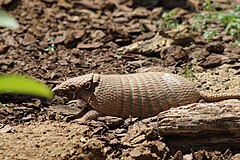Puklerznik
| Euphractus | |||
| Wagler, 1830[1] | |||
 Przedstawiciel rodzaju – puklerznik sześciopaskowy (E. sexcinctus) | |||
| Systematyka | |||
| Domena | |||
|---|---|---|---|
| Królestwo | |||
| Typ | |||
| Podtyp | |||
| Gromada | |||
| Podgromada | |||
| Rząd | |||
| Rodzina | |||
| Podrodzina | |||
| Rodzaj |
puklerznik | ||
| Typ nomenklatoryczny | |||
|
Dasypus sexcinctus Linnaeus, 1758 | |||
| Synonimy | |||
|
| |||
| Gatunki | |||
| |||
Puklerznik[7] (Euphractus) – rodzaj ssaków z podrodziny puklerzników (Euphractinae) w obrębie rodziny Chlamyphoridae.
Zasięg występowania[edytuj | edytuj kod]
Rodzaj obejmuje jeden żyjący współcześnie gatunek występujący w Ameryce Południowej[8][9][10].
Morfologia[edytuj | edytuj kod]
Długość ciała (bez ogona) 400–500 mm, długość ogona 200–250 mm, długość ucha 35–41 mm, długość tylnej stopy 78–90 mm; masa ciała 3–7 kg[10][11].
Systematyka[edytuj | edytuj kod]
Rodzaj zdefiniował w 1830 roku niemiecki przyrodnik Johann Georg Wagler w książce swojego autorstwa o tytule Natürliches System der Amphibien, mit vorangehender Classification der Säugethiere und Vögel[1]. Wagler nie wskazał gatunku typowego; w ramach późniejszego oznaczenia w 1904 roku amerykański zoolog Theodore Sherman Palmer na typ nomenklatoryczny wyznaczył puklerznika sześciopaskowego (E. sexcinctus)[12].
Etymologia[edytuj | edytuj kod]
- Euphractus (Euphrectus): gr. ευ eu „dobrze”; φρακτος phraktos „chroniony, zabezpieczony”, od φρασσω phrassō „wzmocnić”[12].
- Encoubertus: port. encuberto lub encubertado „chroniony”[13]. Gatunek typowy: Dasypus sexcinctus Linnaeus, 1758.
- Pseudotroctes: gr. ψευδος pseudos „fałszywy”; πρωκτης prōktēs „gryzący, skubiący”[14]. Gatunek typowy: Dasypus setosus[c] Wied-Neuwied, 1826.
- Scleropleura (Scelopleura): gr. σκληρος sklēros „sztywny, twardy”; πλευρα pleura „bok”[15]. Gatunek typowy: Scleropleura bruneti Milne-Edwards, 1871 (= Dasypus sexcinctus Linnaeus, 1758).
Podział systematyczny[edytuj | edytuj kod]
Do rodzaju należy jeden występujący współcześnie gatunek[16][11][8][7]:
- Euphractus sexcinctus (Linnaeus, 1758) – puklerznik sześciopaskowy
Opisano również gatunek wymarły z plejstocenu Argentyny[17]:
- Euphractus minimus Ameghino, 1881
Uwagi[edytuj | edytuj kod]
Przypisy[edytuj | edytuj kod]
- ↑ a b J.G. Wagler: Natürliches System der Amphibien, mit vorangehender Classification der Säugethiere und Vögel. Ein Beitrag zur vergleichenden Zoologie. München, Stuttgart und Tübingen: In der J.G. Cotta’scchen Buchhandlung, 1830, s. 36. (niem.).
- ↑ H. McMurtrie: Edentata. W: G. Cuvier: The animal kingdom arranged in conformity with its organization. Cz. 1. New York: G. & C. & H. Carvill, 1831, s. 163. (ang.).
- ↑ C.W.L. Gloger: Gemeinnütziges Hand- und Hilfsbuch der Naturgeschichte. Für gebildete Leser aller Stände, besonders für die reifere Jugend und ihre Lehrer. Breslau: A. Schulz, 1842, s. 113. (niem.).
- ↑ A. Milne-Edwards. Note sur une nouvelle espèce de tatou a cuirasse incomplète (Scleropleura bruneti). „Nouvelles archives du Muséum d’histoire naturelle”. 7, s. 178, 1871. (fr.).
- ↑ É.L. Trouessart: Catalogus mammalium tam viventium quam fossilium. Wyd. Nova ed. (prima completa). Cz. 2. Berolini: R. Friedländer & sohn, 1898, s. 1141. (łac.).
- ↑ R.J. Ortlepp. A new Trichostrongyle genus from an armadillo, Euphrectus villosus. „The Annals and Magazine of Natural History”. Ninth series. 9 (52), s. 413, 1922. (ang.).
- ↑ a b Nazwy polskie za: W. Cichocki, A. Ważna, J. Cichocki, E. Rajska-Jurgiel, A. Jasiński & W. Bogdanowicz: Polskie nazewnictwo ssaków świata. Warszawa: Muzeum i Instytut Zoologii PAN, 2015, s. 25. ISBN 978-83-88147-15-9. (pol. • ang.).
- ↑ a b C.J. Burgin, D.E. Wilson, R.A. Mittermeier, A.B. Rylands, T.E. Lacher & W. Sechrest: Illustrated Checklist of the Mammals of the World. Cz. 1: Monotremata to Rodentia. Barcelona: Lynx Edicions, 2020, s. 122. ISBN 978-84-16728-34-3. (ang.).
- ↑ D.E. Wilson & D.M. Reeder (redaktorzy): Genus Euphractus. [w:] Mammal Species of the World. A Taxonomic and Geographic Reference (Wyd. 3) [on-line]. Johns Hopkins University Press, 2005. [dostęp 2023-01-14].
- ↑ a b M. Superina & A. Abba: Family Chlamyphoridae (Chlamyphorid Armadillos). W: R.A. Mittermeier & D.E. Wilson (redaktorzy): Handbook of the Mammals of the World. Cz. 8: Insectivores, Sloths and Colugos. Barcelona: Lynx Edicions, 2018, s. 67. ISBN 978-84-16728-08-4. (ang.).
- ↑ a b Class Mammalia. W: Lynx Nature Books (A. Monadjem (przedmowa) & C.J. Burgin (wstęp)): All the Mammals of the World. Barcelona: Lynx Edicions, 2023, s. 79. ISBN 978-84-16728-66-4. (ang.).
- ↑ a b Palmer 1904 ↓, s. 278.
- ↑ Palmer 1904 ↓, s. 258.
- ↑ Palmer 1904 ↓, s. 594.
- ↑ Palmer 1904 ↓, s. 626.
- ↑ N. Upham, C. Burgin, J. Widness, M. Becker, C. Parker, S. Liphardt, I. Rochon & D. Huckaby: Treeview of Mammalian Taxonomy Hierarchy. [w:] ASM Mammal Diversity Database (Version 1.11) [on-line]. American Society of Mammalogists. [dostęp 2023-08-26]. (ang.).
- ↑ F. Ameghino: La antigüedad del hombre en el Plata. T. 2. Paris: G. Masson & Igon Hermanos, 1881, s. 310. (hiszp.).
Bibliografia[edytuj | edytuj kod]
- T.S. Palmer. Index Generum Mammalium: a List of the Genera and Families of Mammals. „North American Fauna”. 23, s. 1–984, 1904. (ang.).
